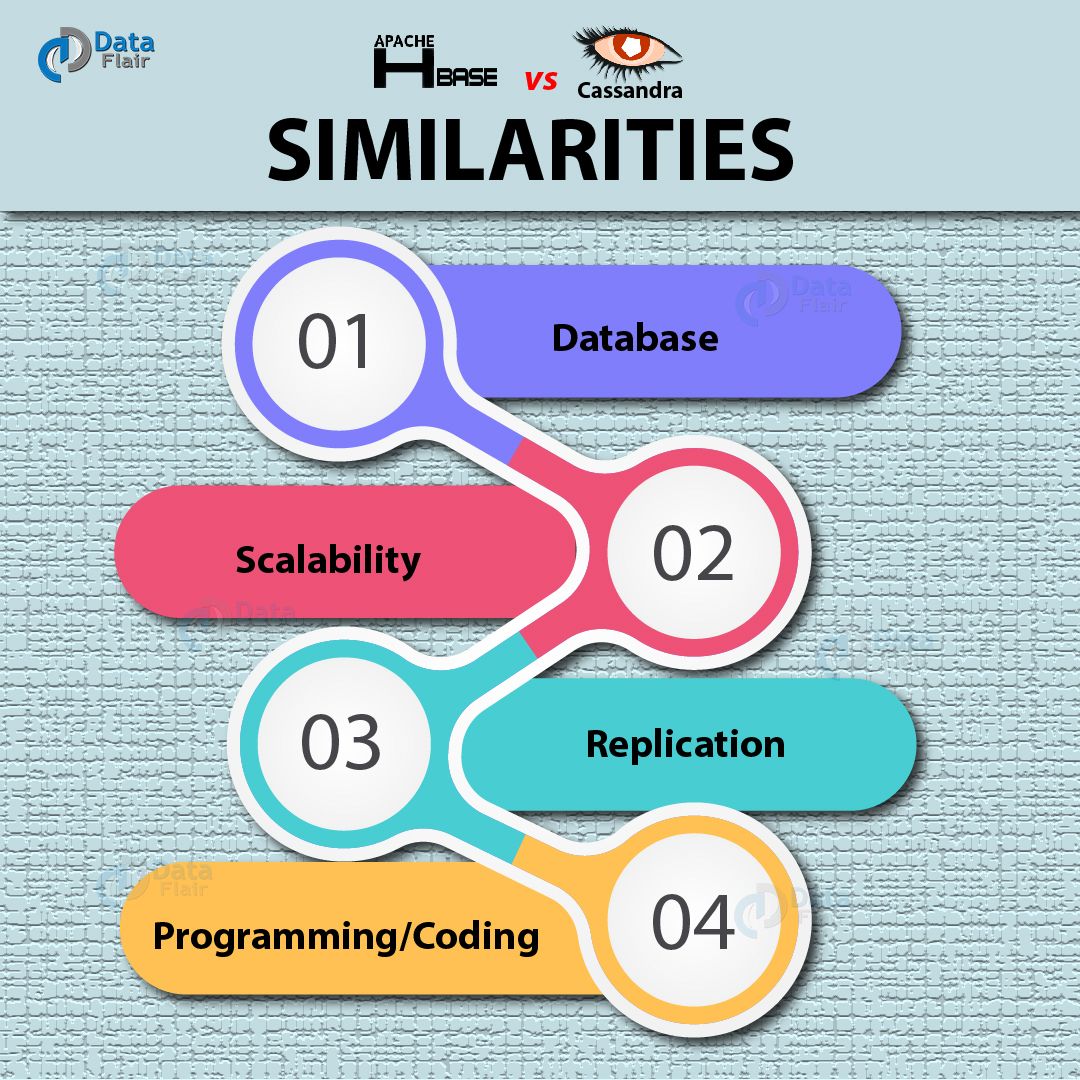HBase vs Cassandra – 8 Major Difference & Similarities
FREE Online Courses: Dive into Knowledge for Free. Learn More!
Both HBase and Cassandra are the NoSQL database and designed to manage extremely large data set. But on the hand, they both are different. In this Cassandra article, we will see HBase vs Cassandra.
Moreover, we will study the similarities between HBase and Cassandra. At last, we will cover the factors of differences between HBase vs Cassandra.
So, let’s start HBase vs Cassandra.
Similarities – HBase vs Cassandra
Cassandra and HBase both are descendants of Bigtable. HBase originated mainly from Bigtable. Cassandra, on the other hand, was derived from Bigtable and Amazon’s Dynamo. Since they have similar characteristics, there are many similarities.
Some of the main similarities between HBase and Cassandra:’
a. Database
Both Cassandra and HBase are open-source NoSQL Database. Both database can manage extremely large data sets and handle non-relational data. This data includes images, videos, audio, etc. In other words, both Cassandra and HBase are born for Big Data.
b. Scalability
Both Cassandra and HBase have a feature of high linear scalability. That means to handle more data, the user should simply increase the number of nodes in the cluster. Because of this feature, they both are an excellent choice for handling a large amount of data.
c. Replication
There is always a chance of failure in a program or application. Because of these failure data can be lost. But in both Cassandra and HBase, there is a safeguard that prevents data loss even after failure. This is done via replication.
The data written on one node is replicated to many nodes in the cluster. Due to this, if a node fails, there is always a redundant node for the data access.
d. Programming/Coding
Both are column-oriented databases that implement similar write paths. The columns are basically the main storage unit in the database. A user can add columns as per their requirements.
Furthermore, the right path begins with logging the write operation to a log file. This is basically done to ensure durability. Both are mainly accessed through Java, which is also the language in which they are written.
e. Distributed Architecture:
HBase and Cassandra are both intended to be distributed databases. As such, they may be set up on several nodes in a cluster and provide horizontal scalability to deal with heavy traffic and enormous volumes of data.
f. HBase and Cassandra both adhere to the NoSQL data paradigm, which implies they are able to store semi-structured or unstructured data without relying on a predefined schema. Agile development is made possible by this adaptability, which also adapts to shifting data needs.
g. The HBase column-family data model divides each table into column families, each of which may include a variety of columns. Data is arranged in columns and rows in Cassandra, where each row may have a distinct collection of columns.
The difference – HBase vs Cassandra
After going through the similarities, we will note some differences between HBase vs Cassandra. Some of these differences are:
a. Infrastructure
HBase utilizes Hadoop Infrastructure. This HBase-Hadoop infrastructure consists of several moving parts like Zookeeper, HBase master, Data nodes and Name Node.
Cassandra, on the other hand, has different infrastructure and operation than Hadoop. However, for many applications, Cassandra uses different DBMS along with their infrastructure.
Many Cassandra applications or programs use Cassandra along with Storm or Hadoop or etc. Its infrastructure is based on single node-type structure. In this, all the nodes perform equally. When used alone, nodes are simply used as a coordinator.
But when Cassandra is used along with different DBMS, the complexity of the infrastructure increases.
b. Support
- HBase, do not supports ordered partitioning.
- HBase offers a coprocessor capability. This capability supports triggers. In HBase, a single row is served by exactly one region server at a time. Therefore, it does not support read load balancing against a single row. HBase supports range based scans as well.
- Cassandra, on the other hand, supports ordered partitioning. This ordered partition leads to make row size in Cassandra up to 10’s of megabytes. Unfortunately, using ordered partitioning creates hot spots for the users.
- While supporting many things Cassandra does not support a few things. Cassandra is also limited in supporting range based row scans. Furthermore, Cassandra does not support coprocessor-like functionality.
c. Nodes
In Cassandra, a user has to identify some nodes as seed nodes. These nodes serve as points for inter-cluster communication. Whereas, in HBase, there are master nodes. These master nodes monitor and coordinate the actions of region servers.
Therefore, high scalability and availability in Cassandra are ensured by allowing multiple seed nodes in a cluster. On the other hand, we ensure the same by standby master nodes in HBase. In case the main master node fails, the standby node is ready to take its place.
d. Internode Communication
There is internode communication in both Cassandra and HBase. However, Cassandra uses Gossip Protocol for it. After this, the data will transfer from one node to another. In other words, we replicate the data.
For this internode communication, HBase relies on Zookeeper Protocol. In this, one node acts as the boss through which all the other nodes gets the data.
e. Transactions
Cassandra has a feature of lightweight transactions. The mechanisms used in the transaction are ‘Compare and Set’ and ‘Row-level Write Isolation’. On the other hand, HBase has two mechanisms for these transactions.
One of them is ‘Check and Put’ and the other is ‘Read-Check-Delete’ mechanism.
f. Query language
HBase shell and Cassandra shell, both are based on JRuby Shell. But, Cassandra has a specific Query Language, CQL. CQL is modeled after SQL.
If compared CQL is far richer as according to features and functions than HBase. CQL also knew as the primary programming language for Cassandra.
g. Documentation
Documentation of Cassandra is better than documentation of HBase. Because of documentation, working and learning Cassandra is easier than HBase. Apart from this, setting up of Cassandra Cluster is also easier than HBase Cluster.
h. Miscellaneous
HBase uses bloom filters as a form of indexing. Also across a WAN, it provides asynchronous replication of the clusters as the storage unit.
Whereas, Cassandra uses the bloom filters for key lookup. Across a WAN, Cassandra random partitioning provides row replication of a single row.
So, this was all about HBase vs Cassandra Tutorial 2018. Hope you like our explanation.
Summary of HBase Vs Cassandra
Hence, in this HBase vs Cassandra article, we learned about the differences between HBase and Cassandra. In addition, we discussed some similarities between HBase and Cassandra.
In the next article, we will go through the differences between Cassandra and RDBMS. Furthermore, if you have any query, feel free to ask in the comment section.
If you are Happy with DataFlair, do not forget to make us happy with your positive feedback on Google







Aw, this was an extremely nice post. Taking a few minutes and
actual effort to create a great article… but what can I say… I procrastinate a lott and don’t manage to gett anything done.
Glad, we like our post on “HBase vs Cassandra”, Thanks for being a loyal reader.